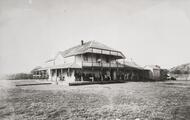

The Scout and the Lady
Scope and Content Notes
The Scout and the Lady is a ledger art drawing created by a warrior and artist named Washee (Arapaho, Cheyenne) in 1887. Ledger art was grounded in Plains painting techniques, which emphasize figures, gestures, postures, and clothing to inform the viewer about the narrative (that is, the actions and activities of the subjects). Importantly, ledger art was created from the lived experiences of warrior-class males among the Cheyenne. Here, Washee rides in on horseback to court a young lady. He wears a red wool breechcloth and painted hide leggings, and is wrapped in a black wool blanket. He also carries a parasol as both a display of successful trade and for protection from the sun. Washee’s horse is marked by two crossed lines on its shoulder and thigh. The young women are wearing matching trade-cloth dresses with blue ribbon trim along the hemline. They are wrapped in shawls and carry parasols decorated with two tassels. Their cheeks are painted red, and their hair is in modest braids. Courtship scenes were often depicted in ledger books as warrior artists recorded their personal experiences and memories.
Fort Reno was established in Indian Territory to colonize the region (now Oklahoma) in 1874. Not long after, more than thirty Cheyenne and Arapaho men and one woman defied the military takeover of the land, and they were arrested and sent to Fort Marion (now called Castillo de San Marcos) in St. Augustine, Florida. At Fort Marion, attempts were made to assimilate and colonize the prisoners, who were encouraged to renounce their culture, and were given Western educations and taught to speak and write English. They also continued to make narrative figurative drawings and paintings, although now using media such as graphite, ink, colored pencils, oil pastels, and watercolors on paper rather than natural pigments and hide. The works are called ledger art because the paper was from accountants’ ledger books. After they were released from prison in 1878, several Fort Marion survivors returned to Fort Reno, where they enlisted as scouts and continued drawing.
—Jordan Poorman Cocker, Henry Luce Foundation Curatorial Scholar for Indigenous Painting Collection Research, 2021
_____________________________
This text was informed in part through consultations with Gilcrease curatorial assistant Jenny Keller, and with Cheyenne and Arapaho Culture Program coordinators Fred Mosqueda and Chester Whiteman.





